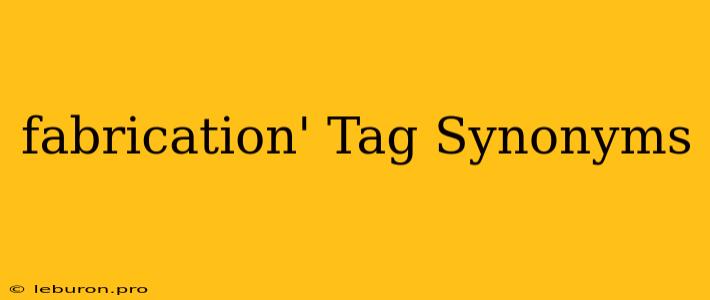Fabrication is a broad term that encompasses a wide range of processes used to create objects, structures, and systems from raw materials. It plays a crucial role in various industries, from manufacturing and construction to aerospace and medicine. Understanding the different types of fabrication and their applications is essential for professionals working in these fields. This article delves into the intricacies of fabrication, exploring its diverse methods, applications, and the key factors that contribute to successful fabrication processes.
Types of Fabrication
Fabrication methods can be broadly categorized based on the materials used and the processes employed. Here are some common types of fabrication:
Metal Fabrication
Metal fabrication involves shaping and forming metal materials using various techniques, including:
- Cutting: Processes like shearing, sawing, laser cutting, and waterjet cutting are used to separate metal sheets or bars into desired shapes.
- Forming: Bending, rolling, stamping, and forging are used to shape metal sheets or bars into desired profiles.
- Joining: Welding, brazing, soldering, and riveting are employed to connect metal parts permanently.
- Machining: Processes like milling, turning, drilling, and grinding are used to create precise shapes and features on metal parts.
Metal fabrication finds widespread applications in industries like automotive, aerospace, construction, and manufacturing.
Plastic Fabrication
Plastic fabrication utilizes various methods to shape and form plastic materials. These methods include:
- Injection Molding: This process involves injecting molten plastic into a mold cavity, creating complex shapes and designs.
- Extrusion: Plastic is forced through a die with a specific cross-section, producing continuous profiles like pipes, tubes, and sheets.
- Thermoforming: A heated plastic sheet is formed over a mold to create a desired shape.
- Rotational Molding: Molten plastic is rotated within a mold to create hollow objects.
Plastic fabrication is widely used in industries like packaging, consumer goods, automotive, and construction.
Wood Fabrication
Wood fabrication involves the shaping and joining of wood to create furniture, structures, and other products. Common techniques include:
- Sawing: Cutting wood into specific lengths and shapes using saws.
- Planing: Smoothing wood surfaces using planers.
- Joining: Connecting wood pieces using nails, screws, glue, or dowels.
- Turning: Creating rounded shapes on wood using a lathe.
Wood fabrication is crucial in the furniture industry, construction, and woodworking crafts.
Other Fabrication Methods
Besides the mentioned fabrication methods, others include:
- Composite Fabrication: Combining different materials like fiber-reinforced polymers to achieve desired properties.
- Additive Manufacturing (3D Printing): Creating three-dimensional objects layer by layer from a digital design.
- Casting: Pouring molten metal or plastic into a mold to create a desired shape.
The choice of fabrication method depends on the specific requirements of the project, including material properties, desired shape, and production volume.
Factors Influencing Fabrication
Several factors play a significant role in successful fabrication processes. These include:
- Material Selection: The choice of material is crucial based on its properties like strength, durability, weight, and cost.
- Design Considerations: The design of the fabricated product should be optimized for manufacturing efficiency and functionality.
- Equipment and Tools: The availability and suitability of fabrication equipment and tools are vital for efficient production.
- Process Control: Precise control over fabrication processes is essential for ensuring quality and consistency.
- Safety Practices: Implementing robust safety practices during fabrication is paramount for worker protection.
- Cost Optimization: Balancing production costs with quality and performance is essential for successful fabrication.
Applications of Fabrication
Fabrication processes are integral to diverse industries, including:
- Manufacturing: Producing a wide range of products from consumer goods to industrial machinery.
- Construction: Building structures, bridges, and infrastructure projects.
- Aerospace: Manufacturing aircraft, spacecraft, and aerospace components.
- Automotive: Producing vehicles, parts, and accessories.
- Medical: Creating medical devices, implants, and surgical tools.
- Energy: Fabricating components for power generation and transmission.
Challenges in Fabrication
Fabrication faces several challenges, including:
- Material Availability: Sourcing high-quality materials can be challenging, especially for specialized applications.
- Technological Advancements: Keeping up with rapidly evolving fabrication technologies is crucial for staying competitive.
- Skilled Labor Shortage: Finding qualified personnel with fabrication skills is a significant challenge.
- Sustainability Concerns: Minimizing waste and reducing environmental impact during fabrication is becoming increasingly important.
- Cost Pressure: Balancing production costs with quality and efficiency is a continuous challenge.
Future Trends in Fabrication
The field of fabrication is constantly evolving with new technologies and advancements. Some key trends shaping the future include:
- Additive Manufacturing (3D Printing): This technology is revolutionizing fabrication by enabling the creation of complex and customized objects.
- Automation and Robotics: Automation is increasingly being integrated into fabrication processes to enhance efficiency and reduce human error.
- Sustainable Fabrication: Focus is shifting towards developing fabrication methods that minimize waste and environmental impact.
- Advanced Materials: New materials with enhanced properties are being developed for specific applications.
- Digital Twins: Virtual representations of fabricated products are being used to optimize design and manufacturing processes.
Conclusion
Fabrication plays a vital role in modern society, enabling the creation of countless products and structures that improve our lives. Understanding the diverse types of fabrication methods and their applications is crucial for professionals working in various industries. As the field continues to evolve, embracing new technologies and sustainability practices will be essential for the future of fabrication. The fabrication industry faces challenges but also exciting opportunities as it strives to meet the increasing demands for innovative and high-quality products.
